Actual Jobs Lost v. Unemployment Rate in February
This is a quibble! But have you noticed how all financial news-about unemployment, or new housing sales, and the like-always centers on the “rate” of change? So all the news is headlined as “Jobless rate is unchanged.” But this “unchange” means that 36,000 more jobs disappeared in the month of February. Why is it of use to us to track a rate? That’s of use to the government, or historians, and maybe economists. It’s of use to readers to say something like: “The number of new jobs lost in February alone is greater than the entire population of Ithaca, New York.”
Henry Blodget Can't Quite Afford Investigative Journalism Either
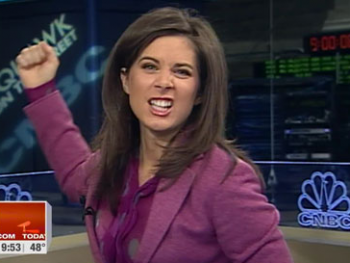
Henry Blodget is learning some hard truths (again)! This morning he’s gone all up on the Twitter, to explain, on behalf of his publication, Business Insider, that investigative reporting is time-consuming and expensive! (Did you know that?) “All right, look, here’s the truth about this investigative reporting thing…” he wrote. “Everyone says they want more of it. No more aggregation, please. No more links. No more slideshows. No more picture [sic] of Erin Burnett.” He is talking about Nick Carlson’s new story on the origin of Facebook, but he simply can’t give these kinds of stories to you all the time! “But the truth is, if we tried to do 3 a day, with our staff, we would DROP DEAD. We’d also go bust. Neither being a happy outcome.” So: “We’re going to try to give you one of these once in a while. You like reading ’em. And we like making ‘em.” But? Yes, there is a but: “And we’re going to give you house porn, and features, and pictures of Erin Burnett. Because, truth be told, you GROOVE on that sh*t!” It is I guess true. Come for the Squawk on the Street pics, stay for the elaborate historical investigations. (Or is it the other way around?)
Gay Vatican Sex Rings in Translation: Ball Touching Actually Legit

Yesterday’s highly amusing/creepy news about the alleged Vatican-adjacent prostitution ring is getting the treatment that all non-English language news gets: iffy translations that leave more than nuance behind. So yesterday’s pullquote everywhere went like this: “You’ll get up to 2,000 euros… Do not touch his balls. You need the money. Put on some music, take out the [inaudible], swallow the Viagra, and adelante!” Fortunately, Our Special Italian Correspondent for Sex Rings can assist with the original, particularly that whole “no touching of balls” weirdness? She writes: “’Non rompere il cazzo’ is an idiomatic phrase which literally translates as ‘Don’t break my dick,’ but which means ‘Don’t be a pain in the ass! Don’t annoy me!’ (basically the same as ‘Don’t break my balls’ as said by some trucker in Bay Ridge or something), but they translate it as ‘Don’t touch his balls.’ Salacious…but unfounded.” Ha, yes, that actually does change the tenor of the wiretapped conversation-instead of being about providing sexual directives, that part instead appears to be a price-haggling conversation. Far more Italian!
John Roberts Rumor Started To Prove Point Proves Point

This is pretty great: Above the Law pegs yesterday’s “John Roberts is Retiring” rumor to a Georgetown Law class about… rumors and trusted sources. Unfortunately, most of the professor’s students were too busy sexting about the news to reflect upon the actual topic of the lecture: “on the credibility and reliability of informants,” and when the professor, Peter Tague, revealed he was just teaching them a lesson, they had to re-sext all their friends that, no, John Roberts was not indeed going to retire yesterday. Love it.
Why Apple Deserves an Oscar Too
by Abe Sauer

Avatar is in contention for an Oscar because it dominated its field, both technologically and financially. But another cinematic player was even more dominant last year: Apple. In the 44 films in 2009 that topped the box office for at least one weekend, an Apple logo or device could be seen in at least 18 of them. (That’s almost 41%.) In some, Apple products even eclipsed their human scene partners. This high appearance rate does not include the heap of mass-market films from 2009 that did not own a weekend but also featured Apple product placement.
Just to name a few of those? That list includes Drag Me to Hell, Orphan, I Love You, Man, Duplicity, Crank 2: High Voltage, Ghosts of Girlfriends Past, Imagine That, Sorority Row, Answer Man, Post Grad, I Love You Beth Cooper, All About Steve, Hurt Locker, New York, I Love You, It’s Complicated, Road Trip: Beer Pong, Law Abiding Citizen, Fantastic Mr. Fox, Funny People and Couples Retreat.
These numbers also don’t include the mountain of other films and TV shows, from Macs on Regis and Kelly and Jimmy Fallon’s desks to the Mac grotesquerie of The Office and 30 Rock. Fruity logo out front, advertisement aglow.
For one month in 2009, product placement tracking service Nielsen IAG noted 62 total “occurrences” of Apple products, more than any other brand, including AT&T (59), Coca-Cola (55) or Ford (41). Playboy, even with a whole show crafted around its brand name, logged a comparatively paltry 21 occurrences.

This is a downturn from 2008, when Apple appeared in exactly half of the 40 #1 films. This achievement comes at the end of a decade-long climb for Apple.
Last year, Apple’s product placement plan finally topped the heap as well-with Apple appearing in more #1 films than any other brand, including Ford and Pepsi, which had held the most appearances for every year going back to 2001 (except 2003, when the #1 was Cadillac).
Brandchannel.com’s weekly product placement tracking feature Brandcameo shows that Apple has appeared in 102 of the 302 weekly number one U.S. box office films from 2001 to 2009-more than 33% of them. Apple’s number is actually higher when period and fantasy/scifi films, in which Apple could not appear, are removed (the Lord of the Rings trilogy, Star Wars
prequels 3:10 to Yuma, etc.).
Measured against Apple’s real market share, there is a deeply inauthentic nature to many of Apple’s appearances, particularly films set in administrative hells where the brand is rarely found, whether hospitals (Scrubs) or government offices (24, Law Abiding Citizen). Apple’s “accomplishment” is made all the more extraordinary considering how automobile brands, like Ford, so easily and inconsequentially appear in a film (taxis in films are almost always Fords). Meanwhile, Apple products have to be very deliberately placed by a set designer.
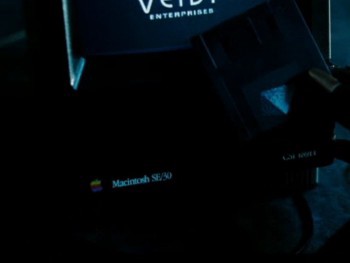
Hamish Purdy, the assistant set decorator for Watchmen (which featured an Apple “Easter egg”) explains, to some degree, how this happens. “One thing we often have to deal with is ‘clearance’ to use a product on a set. If the item has been ‘product placed,’ clearance is inherent. Apple has always been willing to provide product for sets without too much hassle.”
Yeah, just so that is clear: Apple does not pay for any of this exposure.
As for how Apple products in scenes don’t always lend realism, Purdy said, “With shows like CSI, the number one place people ‘learn’ about FBI work and police stations, the truth of it is horribly and inaccurately dramatized. Because the public feels this is what a police station looks like, other shows have to at least take a page from that design so that it registers with the public. We have created our own monster. A real police station would just look too boring and even ‘fake.’”
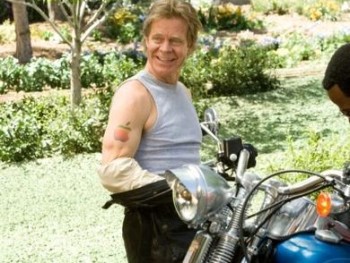
Apple products have become so expected onscreen that things have gotten bizarre. The 2007 hit film Wild Hogs featured a character getting an Apple logo tattoo despite an earlier scene with him not even using an Apple computer. The television show Worst Week attempted to pass off an iPod Touch as an iPhone and when the show Knight Rider went out of its way to use a no-brand prop phone (clearly a Sony Xperia) the show was criticized: “Knight Rider Clones the iPhone, Poorly.” That is to say, a show that did not use an Apple product was disparaged for not just using an Apple product.
Even the latest Star Trek, which features no Apple products, had some calling the starship design a “super duper Apple store,” an “internal Apple store of tomorrow,” “looks like the SS Apple Store,” “an Apple Store 10 years in the future,” and “Would you like a tour of the iBridge?” [all sic.] (Interestingly enough, in 1999, Star Trek director J.J. Abrams told Entertainment Weekly of his then-hit show Felicity’s many Mac placements, “For me, this is strictly a cultural phenomenon. There’s something human and friendly and optimistic about Macintosh.”
Apple’s rich history of product placement reaches back to the Mac’s original era of market dominance, appearing in many 1980s films like Short Circuit and Real Genius. The 1990s saw Apple make a active effort to highlight its film roles, openly advertising its Mission Impossible and Independence Day tie-ins. Apple was also hyper-aggressive, with product placing legend Suzanne Forlenza pushing Mac infiltration into television shows such as Veronica’s Closet, Seinfeld, Ally McBeal, Buffy the Vampire Slayer, Dharma & Greg, Felicity, The Drew Carey Show, X-Files, Real World and Just Shoot Me and films You’ve Got Mail
(obviously) and Jurassic Park.
So it’s notable that Apple now makes the same active effort to not draw attention to its outlandish level of product placement. The brand recently even disabled its official “Starring Apple” webpage that highlighted the Apple’s many cinematic achievements. In character, Apple declined to comment for this piece or about the fate of that page.

Apple is essentially like Hollywood itself, beautiful, expensive and not at all representative of reality. And just like disbelief is suspended when Angelina Jolie or Brad Pitt portray normal people, Apple product placement is dismissed as creative license.
So the greater question is, how does all this product placement benefit Apple? Does it at all? Apple computer sales have spiked in recent years. The reasons for this range from “people are learning the truth” to a halo effect created by the iPod and the iPhone. Comparing Apple’s product placement numbers since 2001 with its sales and market share, there appears to be an overall increase, though certainly nothing concrete. If anything, initial data show the increase in Apple onscreen placements (the vast majority of which are computers) to be linked to the explosion of the iPod, which also happened to be the explosion of Apple’s Q Rating.
Tim Aikin, founder and CEO of Boxwish, a site that creates a community of product placement spotters who solve the great quandary of how products can take advantage of their placements, says that as the Apple brand, having always polarized consumers, “has grown its market share from niche player to mass producer, thanks to the iPod, Intel-based Macs, iTunes and now the iPhone, they need to soften this polarization without losing their core audience and still maintaining a certain sense of exclusivity.”
Aikin said that Apple’s product placement is a success because it counteracts the boring sameness inherent in becoming a mass-market leader. “Apple is able to keep the brand ‘cool’ by having the stars of the movie use the products most overtly and then also throw in the ‘Easter eggs’ to maintain a connection with the core audience that gave Apple so much success in its early years.”
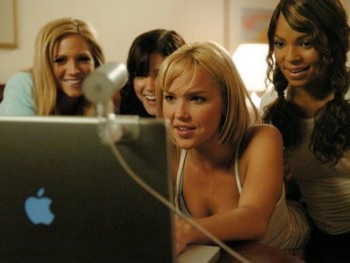
As you can tell, product placement is notorious for having no solid criteria to benchmark success. Like the Brandchannel and Nielsen IAG numbers, most product placement data cite “occurrences” and few results outside the pathetically overly-cited, such as E.T. and Reese’s Pieces.
A 2009 study of household computer ownership found that “approximately 12 percent of all U.S. computer owning households own an Apple computer, up from 9 percent in 2008.” While 12 percent representation in the real-world is nowhere near its 50 percent onscreen rate, it still possible that, in conjunction with iPhone and iPod halo effects, all of the free Apple product placement benefits the brand. It’s essentially the Head On “apply directly to the forehead” approach of repetition; see Apple after Apple after Apple after Apple after Apple after Apple after Apple in everything everywhere onscreen and a person becomes much more open to considering one of those Macs he’s hearing so much about.
Then there are the brain scans.
For his latest book, Buyology: Truth and Lies About Why We Buy, Martin Lindstrom conducted scanning to investigate unconscious brain activity in response to marketing, including product placement. When it comes to Apple and product placement, Lindstrom says Apple is maybe the most sophisticated player in the market: “What we know today is that a cognitive link between the storyline and the actual brand often scares the consumers away; it simply is too much ‘in your face.’ Non-conscious links therefore will be the future. The best example of such synergy is what we witness in Wall-E where the Apple logo never is present.” Lindstrom says that even though the Apple “brand” is rare in Wall-E, audiences make an unconscious value transfer from the movie to the brand. “Such value transfer is, according to the Buyology study, most prominent when the viewer isn’t aware of the product placement at the rational level in the brain and only at a non-conscious level.”
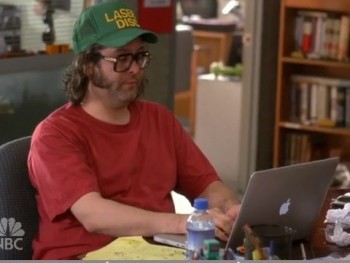
More odd is that Apple’s increasingly conspicuous product placement dominance draws few complaints when compared to the lesser efforts of brands like Pepsi, General Motors, or Starbucks. The full spectrum of product placement oppositionists, from those who reject the practice because it “compromises art” to those who see it as manipulative marketing, seem to be far more upset about the occasional McDonald’s placement than a brand that has appeared in more than one third of all box-office hits since 2001. A great illustration of this phenomenon is the show 30 Rock, which has been taken to task for its product placements, especially its McDonald’s McFlurry episode, even while the same show’s pornographic Mac and iPhone appearances passes with little comment.
About Apple’s Teflon status, Aikin says that Apple’s placements are often used in context, such as fulfilling an action in a movie, and aren’t “just an overt Pepsi truck going through a scene.” He also says: “The products look good. The increasing popularity of our site serves to show that many movies act almost like a how-to guide to being contemporary and relevant. Our audience wants to be inspired by movies and Apple, arguably an inspirational brand, fits this well.”
Leander Kahney, author of Inside Steve’s Brain, The Cult of Mac and The Cult of iPod and author of the blog Cult of Mac, says of Apple product placement: “Apple revels in this kind of thing. Apple has always been overrepresented in movies and TV shows. Its profile far exceeds its market share. But there’s never been a backlash and there never will. People are more likely to aspire than revolt.”
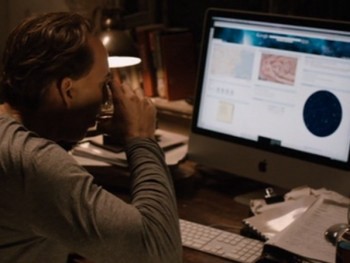
Buyology
study might nail the reason why Kahney is right. Lindstrom points to how preconceived notions about the Apple brand lend it a cloak of immunity against criticism. “You’re left second guessing if Apple had paid for the placement or not. Apple is not perceived as one of the bad guys-brands such as BP, McDonald’s and Microsoft often are, either because they’re seen as being the companies destroying the environment, being unhealthy or greedy.” And sure enough Buyology showed that part of what makes Apple’s product placements immune from criticism is that it isn’t seen as a product at all. “Apple has steered clear of this reputation because the brand is more a religion than anything else,” said Lindstrom. “[The study] showed a clear correlation between the brand Apple and the faith of Christianity. And due to such status, people rarely will question the presence of the brand, just as they wouldn’t question why various religions are featured in movies.”
But how long will audiences, and especially prop managers, continue to think different about Apple and its product placement? As Apple becomes more mass market it may find its culture role increasingly difficult, which in turn may endanger all of its free onscreen exposure.
There is evidence this is already happening. In small increments, Apple product placement that might have been is being stifled by producers camouflaging the glowing fruit with any number of tricky set props. A pencil jar here; a yellow stickie note there.
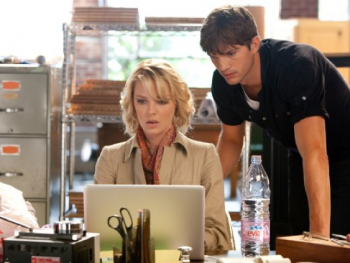
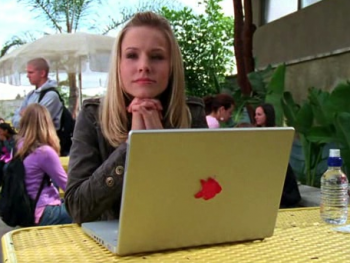
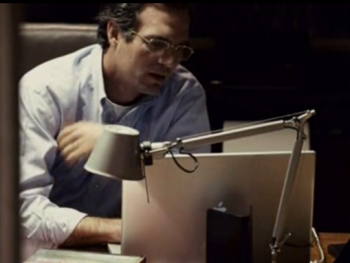
Apple’s product placement pace will remain strong in 2010, with Apple placements already confirmed in the films Book of Eli, When in Rome, Kick Ass, Chloe, The Killers, Wall Street 2, City Island, She’s Out of My League, The Joneses, The Spy Next Door, Percy Jackson: Lightning Thief, Valentine’s Day, The Bounty Hunter and Toy Story 3. But the fat years of being a film darling may be on the decline. Even Madonna eventually got married and had kids.
Coming soon: The top ten most important Apple product placements of all time.
Abe Sauer can’t stop seeing Apple logos everywhere now.
Reflections On The Gowanus Canal
“Cul-de-sacs, like the one on Douglass Street, serve as observation posts. At one, Alberto Lasso keeps his collection of empty bottles, gathered from the surrounding streets in carts he built with help from a local welder. Mr. Lasso comes to the same spot every night, sorting bottles of imported beer into cardboard boxes to return for their 5-cent deposits. Once, he saw a car plow through the metal barrier at the end of the street and land in the canal. But otherwise, it’s quiet. ‘That’s why I’m here,’ Mr. Lasso said.”
–Kareem Fahim’s ode to the Gowanus Canal in today’s Times is nice to read. And the accompanying collection of readers’ paintings and photos is nice to look at. But my favorite thing about the canal will always be the recurring joke in Jonathan Lethem’s Motherless Brooklyn about it being “the only body of water in the world that was 90 percent guns.”
The Squid And The Wail

To Knifecrime Island, where… oh, just read it: “AN alleged pervert was caught with a picture of a man having sex with a dead SQUID, a court heard today. Andrew Dymond, 46, was netted when cops apparently found a haul of grossly offensive porn on his home computer. JPs heard the sea creature was clearly dead in the picture and a man was having sexual intercourse with it.” You’ll want to click through on this one for the accompanying photo. Also, there is this: “Four of the allegations state he had images showing acts likely to cause ‘serious injury to a woman’s breasts’ and private parts.” Can I get a “what a world”? Thank you.
After Bargaining and Acceptance Come Home Surgery
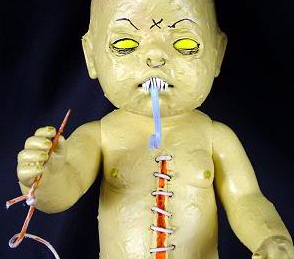
Americans are comparison-shopping for emergency room services, because we are smart. For instance! “When Heather Staples’ 6-year-old daughter, Sophia, fell and cut her eyebrow, Staples knew her daughter might need stitches. But instead of running straight to an emergency room, Staples took a few minutes to compare prices at nearby emergency rooms.” She saved $500, therefore only paying $1200 for some needle and thread. We all know where this is going. Seriously you lazy woman, get a fish hook and some plastic thread and sew that little klutz up yourself.
Canadian PSAs Odd, Canadian
Canadian PSAs Odd, Canadian
Listicles about commercials always do well on the Web, so we’re pleased as punch to point out this compilation of crazy Canadian PSAs assembled by our good pals at Gawker.tv-the happy version of Gawker.com. While I’m disturbed by the dearth of bear-related content here, the post is as good an explanation as any I’ve seen for the bland weirdness exhibited by the tundra farmers to our north: They learned it by watching these! (Some bonus Canadian amusement can be found here.)
Another Paterson Aide Resigns
Who will be the last to quit? “Gov. David Paterson’s communications director Peter Kauffmann has resigned his post, effective close of business today…. This comes on the heels of yesterday’s ethics charge against the governor in which it became clear that Paterson had not been truthful with Kauffmann about the circumstances surrounding the World Series game for which he obtained tickets from the New York Yankees. Kauffmann is the third member of the Paterson administration to resign over the latest round of scandals.”
